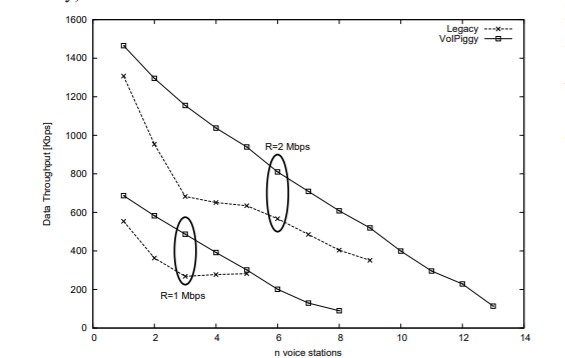IMDEA Networks

VoIPiggy proposes a new MAC enhanced mechanism to improve the performance in 802.11 WLANS
26 March 2012

A study proposes a new 802.11 MAC mechanism for improving the performance in WLANs when voice traffic is present. In practice, VoIPiggy doubles the capacity of a WLAN when voice calls come into play.
Nowadays, Skype, Viber, Ekiga and other-voice over IP applications are widely utilized, given their ease of use and cheap costs. Nevertheless, supporting voice traffic in existing wireless LANs results extremely inefficient due to the large overhead of the 802.11 protocol to transmit short packets, such as the ones used in voice applications, and to the need of prioritizing voice traffic over other transmissions, such as bulky transfers.
The study “VoIPiggy: Implementation and evaluation of a mechanism to boost voice capacity in 802.11 WLANs” was presented at the premier conference for the telecommunication and networking research community, IEEE INFOCOM 2012 (the 31st Annual IEEE International Conference on Computer Communications), held in Orlando, USA, in March 2012. The research was a joint effort by Pablo Salvador, Francesco Gringoli, Vincenzo Mancuso, Pablo Serrano, Andrea Mannocci and Albert Banchs. All the authors – except for Francesco Gringoli of University of Brescia, in Italy – were affiliated with Institute IMDEA Networks and University Carlos III of Madrid at the time of developing this work.
Motivated by the limited efficiency of the standard operation of 802.11 with voice traffic, the study proposes a simple mechanism to dramatically reduce the overhead introduced by this protocol, which also results in better resource utilization. The proposal, named VoIPiggy, consists in piggybacking voice frames over MAC acknowledgments (ACKs). Taking advantage of the bidirectional nature of VoIP communications, we extend control frames with user data. This approach synchronizes most of the transmissions in uplink and downlink over the same voice connections without using a dedicated scheduler, thus allowing VoIP traffic to be served with lower delay and jitter, and reducing the average number of nodes contending for the channel. Noticeably, reducing wireless contention frees resources in the system that can be allocated to other kind of traffic and cause a neat increase of the network throughput.
The paper presents an extensive evaluation of a VoIPiggy implementation in a large-scale test-bed consisting of 33 commercial off-the-shelf devices, and validates its operation against the legacy 802.11 operation. The experimental results show dramatic performance improvements in both voice-only and voice-and-data scenarios. In practice, VoIPiggy doubles the capacity of a WLAN when voice calls come into play.
Read more:
VoIPiggy: Implementation and evaluation of a mechanism to boost voice capacity in 802.11 WLANs



Recent Comments